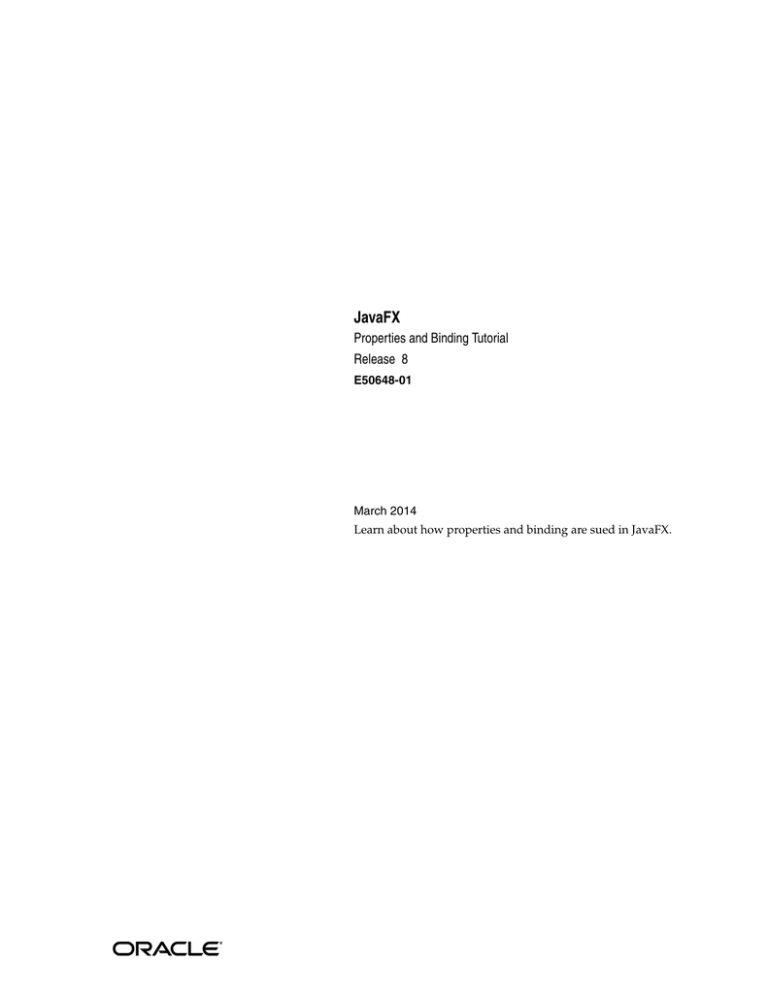
JavaFX
Properties and Binding Tutorial
Release 8
E50648-01
March 2014
Learn about how properties and binding are sued in JavaFX.
JavaFX Properties and Binding Tutorial, Release 8
E50648-01
Copyright © 2011, 2014, Oracle and/or its affiliates. All rights reserved.
Primary Author:
Scott Hommel
This software and related documentation are provided under a license agreement containing restrictions on
use and disclosure and are protected by intellectual property laws. Except as expressly permitted in your
license agreement or allowed by law, you may not use, copy, reproduce, translate, broadcast, modify, license,
transmit, distribute, exhibit, perform, publish, or display any part, in any form, or by any means. Reverse
engineering, disassembly, or decompilation of this software, unless required by law for interoperability, is
prohibited.
The information contained herein is subject to change without notice and is not warranted to be error-free. If
you find any errors, please report them to us in writing.
If this is software or related documentation that is delivered to the U.S. Government or anyone licensing it
on behalf of the U.S. Government, the following notice is applicable:
U.S. GOVERNMENT RIGHTS Programs, software, databases, and related documentation and technical data
delivered to U.S. Government customers are "commercial computer software" or "commercial technical data"
pursuant to the applicable Federal Acquisition Regulation and agency-specific supplemental regulations. As
such, the use, duplication, disclosure, modification, and adaptation shall be subject to the restrictions and
license terms set forth in the applicable Government contract, and, to the extent applicable by the terms of
the Government contract, the additional rights set forth in FAR 52.227-19, Commercial Computer Software
License (December 2007). Oracle America, Inc., 500 Oracle Parkway, Redwood City, CA 94065.
This software or hardware is developed for general use in a variety of information management
applications. It is not developed or intended for use in any inherently dangerous applications, including
applications that may create a risk of personal injury. If you use this software or hardware in dangerous
applications, then you shall be responsible to take all appropriate fail-safe, backup, redundancy, and other
measures to ensure its safe use. Oracle Corporation and its affiliates disclaim any liability for any damages
caused by use of this software or hardware in dangerous applications.
Oracle and Java are registered trademarks of Oracle and/or its affiliates. Other names may be trademarks of
their respective owners.
Intel and Intel Xeon are trademarks or registered trademarks of Intel Corporation. All SPARC trademarks
are used under license and are trademarks or registered trademarks of SPARC International, Inc. AMD,
Opteron, the AMD logo, and the AMD Opteron logo are trademarks or registered trademarks of Advanced
Micro Devices. UNIX is a registered trademark licensed through X/Open Company, Ltd.
This software or hardware and documentation may provide access to or information on content, products,
and services from third parties. Oracle Corporation and its affiliates are not responsible for and expressly
disclaim all warranties of any kind with respect to third-party content, products, and services. Oracle
Corporation and its affiliates will not be responsible for any loss, costs, or damages incurred due to your
access to or use of third-party content, products, or services.
Contents
1 Using JavaFX Properties and Binding
Overview....................................................................................................................................................
Understanding Properties.......................................................................................................................
Using the High-Level Binding API.......................................................................................................
Exploring Observable, ObservableValue, InvalidationListener, and ChangeListener ..............
Using the Low-Level Binding API ........................................................................................................
1-1
1-1
1-4
1-5
1-7
iii
iv
Preface
This preface describes the document accessibility features and conventions used in this
tutorial - Using JavaFX Properties and Binding.
Audience
This document is intended for JavaFX developers.
Documentation Accessibility
For information about Oracle's commitment to accessibility, visit the Oracle
Accessibility Program website at
http://www.oracle.com/pls/topic/lookup?ctx=acc&id=docacc.
Access to Oracle Support
Oracle customers have access to electronic support through My Oracle Support. For
information, visit
http://www.oracle.com/pls/topic/lookup?ctx=acc&id=info or visit
http://www.oracle.com/pls/topic/lookup?ctx=acc&id=trs if you are
hearing impaired.
Related Documents
For more information, see the following documents in the JavaFX documentation set:
■
Getting Started with JavaFX
Conventions
The following text conventions are used in this document:
Convention
Meaning
boldface
Boldface type indicates graphical user interface elements associated
with an action, or terms defined in text or the glossary.
italic
Italic type indicates book titles, emphasis, or placeholder variables for
which you supply particular values.
monospace
Monospace type indicates commands within a paragraph, URLs, code
in examples, text that appears on the screen, or text that you enter.
v
vi
1
Using JavaFX Properties and Binding
1
In this tutorial you learn how to use properties and binding in JavaFX applications.
The tutorial describes relevant APIs and provides working examples that you can
compile and run.
Overview
For many years, the Java programming language has used the JavaBeans component
architecture to represent the property of an object. This model consists of both an API
and a design pattern; it is widely understood by Java application developers and
development tools alike. This release introduces property support into JavaFX,
support that is based on the proven JavaBeans model, but expanded and improved.
JavaFX properties are often used in conjunction with binding, a powerful mechanism
for expressing direct relationships between variables. When objects participate in
bindings, changes made to one object will automatically be reflected in another object.
This can be useful in a variety of applications. For example, binding could be used in a
bill invoice tracking program, where the total of all bills would automatically be
updated whenever an individual bill is changed. Or, binding could be used in a
graphical user interface (GUI) that automatically keeps its display synchronized with
the application's underlying data.
Bindings are assembled from one or more sources, known as dependencies. A binding
observes its list of dependencies for changes, and then updates itself automatically
after a change has been detected.
The binding APIs are divided into two broad categories:
1.
The High-Level API: Provides a simple way to create bindings for the most
common use cases. Its syntax is easy to learn and use, especially in environments
that provide code completion, such as the NetBeans IDE.
2.
The Low-Level API: Provides additional flexibility, and can be used by advanced
developers in situations where the High-Level API is insufficient. The Low-Level
API was designed for fast execution and small memory footprint.
The remainder of this tutorial describes these APIs, and provides working code
examples that you can compile and run.
Understanding Properties
As mentioned in the overview, JavaFX property support is based on the well-known
property model established by the JavaBeans component architecture. This section
Using JavaFX Properties and Binding 1-1
Understanding Properties
provides a brief overview of what that means, then explains how properties apply to
JavaFX.
The Java programming language makes it possible to encapsulate data within an
object, but it does not enforce any specific naming conventions for the methods that
you define. For example, your code might define a Person class, which encapsulates a
first name and a last name. But without naming conventions, different programmers
might choose different names for these methods: read_first(), firstName(),
getFN(), etc. would all be perfectly valid choices. However, there is no guarantee
that these names will be meaningful to other developers.
The JavaBeans component architecture addressed this problem by defining some
simple naming conventions that bring consistency across projects. In JavaBeans
programming, the full signatures for these methods would be: public void
setFirstName(String name), public String getFirstName(), public
void setLastName(String name), and public String getLastName().
This naming pattern is easily recognizable, both to human programmers and to
editing tools, such as the NetBeans IDE. In JavaBeans terminology, the Person object
is said to contain firstName and lastName properties.
The JavaBeans model also provides support for complex property types, plus an event
delivery system. It also contains a number of support classes, all available as an API
under the java.beans package. Therefore, mastering JavaBeans programming
involves learning the required naming conventions and its corresponding API. (For
more background reading on JavaBeans in general, see the JavaBeans lesson of the
Java Tutorial).
Similarly, understanding JavaFX properties also requires learning a few new APIs and
naming conventions. In JavaFX, it is entirely possible that you will only be interested
in using classes that contain properties (as opposed to implementing properties in your
own custom classes), but Example 1–1 will familiarize you with the new method
naming conventions that form the JavaFX property pattern. It defines a class named
Bill, which implements a single property named amountDue.
Example 1–1 Defining a Property
package propertydemo;
import javafx.beans.property.DoubleProperty;
import javafx.beans.property.SimpleDoubleProperty;
class Bill {
// Define a variable to store the property
private DoubleProperty amountDue = new SimpleDoubleProperty();
// Define a getter for the property's value
public final double getAmountDue(){return amountDue.get();}
// Define a setter for the property's value
public final void setAmountDue(double value){amountDue.set(value);}
// Define a getter for the property itself
public DoubleProperty amountDueProperty() {return amountDue;}
}
The amountDue object — an instance of the
javafx.beans.property.DoubleProperty class — is marked as private to
1-2 JavaFX Properties and Binding Tutorial
Understanding Properties
encapsulate it from the outside world. This is standard practice in both Java and
JavaBeans application development. Note however that the object’s type is not one of
the standard Java primitives, but rather, a new wrapper class that encapsulates a Java
primitive and adds some extra functionality (the classes under
javafx.beans.property all contain built-in support for observability and binding
as part of their design).
The property method naming conventions are as follows:
■
■
■
The getAmountDue() method is a standard getter that returns the current value
of the amountDue property. By convention, this method is declared as final.
Note that the return type for this method is double, not DoubleProperty.
The setAmountDue(double) method (also final) is a standard setter that
allows a caller to set the property's value. The setter method is optional. Its
parameter is also of type double.
Finally, the amountDueProperty() method defines the property getter. This is a
new convention in which the method name contains the name of the property
(amountDue, in this case), followed by the word "Property." The return type is the
same as the property itself (DoubleProperty, in this example).
When building GUI applications with JavaFX, you will notice that certain classes in
the API already implement properties. For example, the
javafx.scene.shape.Rectangle class contains properties for arcHeight,
arcWidth, height, width, x, and y. For each of these properties there will be
corresponding methods that match the conventions previously described. For
example, getArcHeight(), setArcHeight(double), arcHeightProperty(),
which together indicate (to both developers and tools) that the given property exists.
You can also add a change listener to be notified when the property's value has
changed, as shown in Example 1–2.
Example 1–2 Using a ChangeListener
package propertydemo;
import javafx.beans.value.ObservableValue;
import javafx.beans.value.ChangeListener;
public class Main {
public static void main(String[] args) {
Bill electricBill = new Bill();
electricBill.amountDueProperty().addListener(new ChangeListener(){
@Override public void changed(ObservableValue o,Object oldVal,
Object newVal){
System.out.println("Electric bill has changed!");
}
});
electricBill.setAmountDue(100.00);
}
}
Running this example will print the message "Electric bill has changed" to standard
output, proving that the change listener notification is working.
Using JavaFX Properties and Binding 1-3
Using the High-Level Binding API
Using the High-Level Binding API
The High-Level API is the quickest and easiest way to begin using bindings in your
own applications. It consists of two parts: the Fluent API, and the Bindings class. The
Fluent API exposes methods on the various dependency objects, whereas the
Bindings class provides static factory methods instead.
To begin using the Fluent API, consider a simple use case in which two integers are
bound so that their values are always added together. In Example 1–3, there are three
variables involved: num1 (a dependency), num2 (a dependency), and sum (the
binding). The dependency types are both IntegerProperty, and the binding itself is
NumberBinding.
Example 1–3 Using the Fluent API
package bindingdemo;
import javafx.beans.property.IntegerProperty;
import javafx.beans.property.SimpleIntegerProperty;
import javafx.beans.binding.NumberBinding;
public class Main {
public static void main(String[] args) {
IntegerProperty num1 = new SimpleIntegerProperty(1);
IntegerProperty num2 = new SimpleIntegerProperty(2);
NumberBinding sum = num1.add(num2);
System.out.println(sum.getValue());
num1.set(2);
System.out.println(sum.getValue());
}
}
This code binds the two dependencies, prints their sum, then changes the value of
num1 and prints the sum again. The results are "3" and "4", which proves that the
binding is working.
You could also use the Bindings class to do the same thing, as shown in
Example 1–4.
Example 1–4 Using the Bindings Class
package bindingdemo;
import
import
import
import
javafx.beans.property.IntegerProperty;
javafx.beans.property.SimpleIntegerProperty;
javafx.beans.binding.NumberBinding;
javafx.beans.binding.Bindings;
public class Main {
public static void main(String[] args) {
IntegerProperty num1 = new SimpleIntegerProperty(1);
IntegerProperty num2 = new SimpleIntegerProperty(2);
NumberBinding sum = Bindings.add(num1,num2);
System.out.println(sum.getValue());
num1.setValue(2);
System.err.println(sum.getValue());
}
}
1-4 JavaFX Properties and Binding Tutorial
Exploring Observable, ObservableValue, InvalidationListener, and ChangeListener
Example 1–5 combines the two approaches:
Example 1–5 Combining Both Approaches
package bindingdemo;
import
import
import
import
javafx.beans.property.IntegerProperty;
javafx.beans.property.SimpleIntegerProperty;
javafx.beans.binding.NumberBinding;
javafx.beans.binding.Bindings;
public class Main {
public static void main(String[] args) {
IntegerProperty num1 = new SimpleIntegerProperty(1);
IntegerProperty num2 = new SimpleIntegerProperty(2);
IntegerProperty num3 = new SimpleIntegerProperty(3);
IntegerProperty num4 = new SimpleIntegerProperty(4);
NumberBinding total =
Bindings.add(num1.multiply(num2),num3.multiply(num4));
System.out.println(total.getValue());
num1.setValue(2);
System.err.println(total.getValue());
}
}
Example 1–5 modifies the code to invoke the multiply method from the Fluent API,
and add from the Bindings class. You should also know that the High-Level API lets
you mix types when defining arithmetic operations. The type of the result is defined
by the same rules as the Java programming language:
1.
If one of the operands is a double, the result is a double.
2.
If not and one of the operands is a float, the result is a float.
3.
If not and one of the operands is a long, the result is a long.
4.
The result is an integer otherwise.
The next section explores observability, and demonstrates how invalidation listeners
differ from change listeners.
Exploring Observable, ObservableValue, InvalidationListener, and
ChangeListener
The binding API defines a set of interfaces that enable objects to be notified when a
value change or invalidation takes place. The Observable and ObservableValue
interfaces fire the change notifications, and the InvalidationListener and
ChangeListener interfaces receive them. The difference between the two is that
ObservableValue wraps a value and fires its changes to any registered
ChangeListener, whereas Observable (which does not wrap a value) fires its
changes to any registered InvalidationListener.
The JavaFX binding and property implementations all support lazy evaluation, which
means that when a change occurs, the value is not immediately recomputed.
Recomputation happens later, if and when the value is subsequently requested.
Using JavaFX Properties and Binding 1-5
Exploring Observable, ObservableValue, InvalidationListener, and ChangeListener
In Example 1–6, the bill total (a binding) will be marked as invalid the first time it
detects a change in one of its dependencies. However, the binding object will
recalculate itself only if the total is actually requested again.
Example 1–6 Using an InvalidationListener
package bindingdemo;
import
import
import
import
import
import
javafx.beans.property.DoubleProperty;
javafx.beans.property.SimpleDoubleProperty;
javafx.beans.binding.NumberBinding;
javafx.beans.binding.Bindings;
javafx.beans.InvalidationListener;
javafx.beans.Observable;
class Bill {
// Define the property
private DoubleProperty amountDue = new SimpleDoubleProperty();
// Define a getter for the property's value
public final double getAmountDue(){return amountDue.get();}
// Define a setter for the property's value
public final void setAmountDue(double value){amountDue.set(value);}
// Define a getter for the property itself
public DoubleProperty amountDueProperty() {return amountDue;}
}
public class Main {
public static void main(String[] args) {
Bill bill1 = new Bill();
Bill bill2 = new Bill();
Bill bill3 = new Bill();
NumberBinding total =
Bindings.add(bill1.amountDueProperty().add(bill2.amountDueProperty()),
bill3.amountDueProperty());
total.addListener(new InvalidationListener() {
@Override public void invalidated(Observable o) {
System.out.println("The binding is now invalid.");
}
});
// First call makes the binding invalid
bill1.setAmountDue(200.00);
// The binding is now invalid
bill2.setAmountDue(100.00);
bill3.setAmountDue(75.00);
// Make the binding valid...
System.out.println(total.getValue());
// Make invalid...
1-6 JavaFX Properties and Binding Tutorial
Using the Low-Level Binding API
bill3.setAmountDue(150.00);
// Make valid...
System.out.println(total.getValue());
}
}
By changing the value of a single bill, the binding becomes invalid, and the
invalidation listener will fire. But if the binding is already invalid, the invalidation
listener will not fire again, even if another bill changes. (In Example 1–6, invoking
total.getValue() moves the binding from invalid to valid.) We know this
because a subsequent change to any bill in the dependency list will cause the
invalidation listener to fire again. This would not happen if the binding was still
invalid.
Note that registering a ChangeListener will enforce eager computation, even if the
implementation of the ObservableValue supports lazy evaluation. For a lazily
evaluated value, it is not possible to know if an invalid value really has changed until
it is recomputed. For this reason, generating change events requires eager evaluation,
while invalidation events can be generated for both eager and lazy implementations.
Using the Low-Level Binding API
If the High-Level API is not enough to satisfy your requirements, you can always use
the Low-Level API instead. The Low-Level API is for developers who require more
flexibility (or better performance) than that offered by the High-Level API.
Example 1–7 shows a basic example of using the Low-Level API.
Example 1–7 Using the Low-Level API
package bindingdemo;
import javafx.beans.property.DoubleProperty;
import javafx.beans.property.SimpleDoubleProperty;
import javafx.beans.binding.DoubleBinding;
public class Main {
public static void main(String[] args) {
final
final
final
final
DoubleProperty
DoubleProperty
DoubleProperty
DoubleProperty
a
b
c
d
=
=
=
=
new
new
new
new
SimpleDoubleProperty(1);
SimpleDoubleProperty(2);
SimpleDoubleProperty(3);
SimpleDoubleProperty(4);
DoubleBinding db = new DoubleBinding() {
{
super.bind(a, b, c, d);
}
@Override
protected double computeValue() {
return (a.get() * b.get()) + (c.get() * d.get());
}
};
System.out.println(db.get());
Using JavaFX Properties and Binding 1-7
Using the Low-Level Binding API
b.set(3);
System.out.println(db.get());
}
}
Using the Low-Level API involves extending one of the binding classes and overriding
its computeValue() method to return the current value of the binding. Example 1–7
does this with a custom subclass of DoubleBinding. The invocation of
super.bind() passes the dependencies up to DoubleBinding so that the default
invalidation behavior is retained. It is generally not necessary for you to check if the
binding is invalid; this behavior is provided for you by the base class.
You now know enough information to begin using the Low-Level API.
1-8 JavaFX Properties and Binding Tutorial






